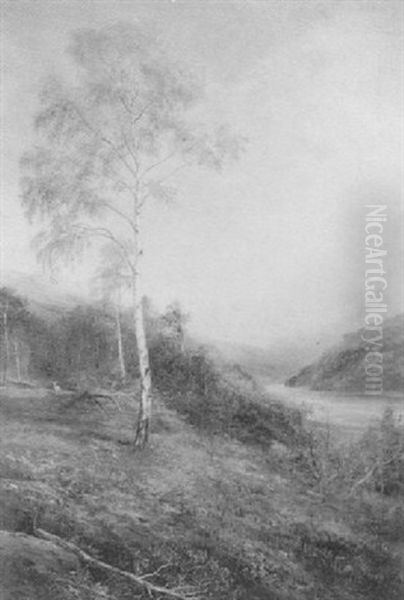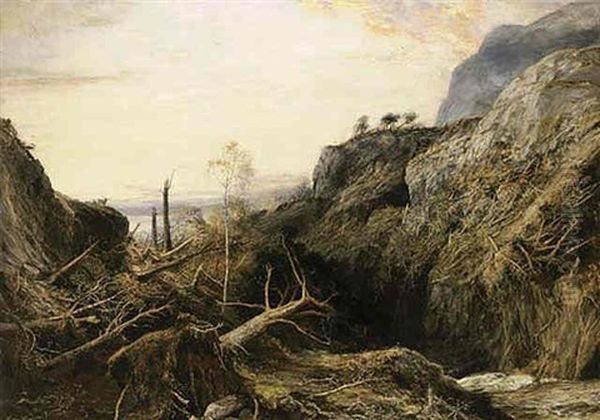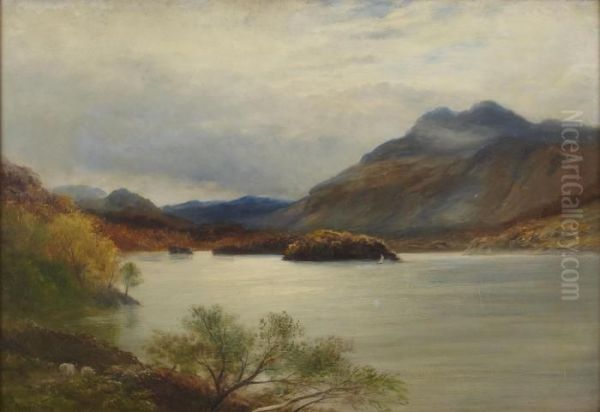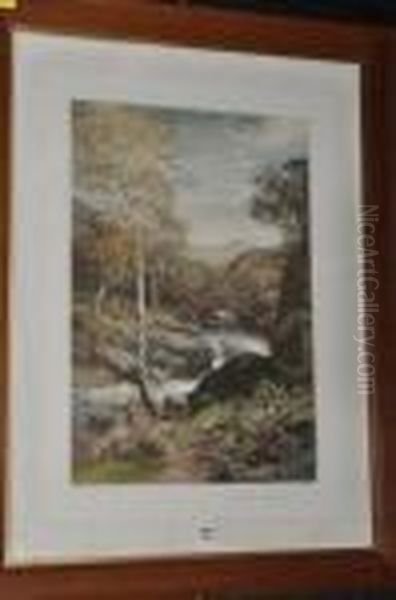Introduction

John MacWhirter (1839-1911) stands as a significant figure in the landscape of Victorian art, a Scottish painter celebrated for his evocative and romantic depictions of the natural world. Born during a time of great change and artistic exploration, MacWhirter carved a distinct path, focusing primarily on landscape painting. His work is characterized by a deep love for nature, particularly the rugged beauty of the Scottish Highlands and the majestic scenery of the Alps, rendered with a poetic sensibility and technical skill that earned him considerable acclaim during his lifetime and secured his place in art history.
Early Life and Artistic Formation
John MacWhirter entered the world in 1839 in Slateford, a village just outside Edinburgh, Scotland. He was the fourth of six children born to George MacWhirter and Agnes Laing. His family background contained elements of both industry and art; his father initially worked as a papermaker in nearby Colinton, later developing interests as a geologist, naturalist, and even a poet. His mother, Agnes Laing, was herself a painter, specializing in still life, suggesting an early artistic environment for the young John.
Tragedy struck the family early when George MacWhirter passed away when John was just eleven years old. Following this, the young MacWhirter briefly undertook an apprenticeship at the Edinburgh booksellers Oliver & Boyd. However, his true calling lay elsewhere, and this venture lasted only a few months. His artistic inclinations soon led him to formal training.
In 1851, MacWhirter enrolled at the Trustees' Academy in Edinburgh, a crucial institution for Scottish art education. Here, he studied under the influential tutelage of Robert Scott Lauder and John Ballantyne. Lauder, in particular, was known for fostering a generation of talented Scottish artists, often referred to as 'Lauder's pupils' or the 'Lauder school', who would significantly shape the direction of Scottish painting. This group included notable figures like William McTaggart, George Paul Chalmers, Hugh Cameron, John Pettie (with whom MacWhirter would later collaborate), and possibly Peter Graham and other 'Grahams' mentioned in records.

Even from a young age, MacWhirter demonstrated a profound connection with the outdoors. He dedicated considerable time to sketching directly from nature, developing his observational skills and fostering an intimate understanding of landscape forms, light, and atmosphere. This commitment bore early fruit; at the remarkably young age of fourteen, he exhibited his first painting, Old Cottage at Braid, at the prestigious Royal Scottish Academy (RSA) in Edinburgh, signalling the arrival of a promising new talent. His sister, Agnes MacWhirter (1833-1911), also pursued an artistic career, focusing on still life painting like their mother.
Forging an Artistic Identity
MacWhirter's artistic journey began during a period when the ripples of the Pre-Raphaelite Brotherhood were being felt across Britain. Like many young artists of the time, he was initially influenced by their emphasis on truth to nature, detailed observation, and bright colour palettes. Figures like John Everett Millais and the influential critic John Ruskin championed this approach. MacWhirter's early work sometimes reflected this meticulous style, evident in the careful rendering of foreground details.
However, MacWhirter did not remain solely within the Pre-Raphaelite mould. As his career progressed, he developed a more personal and distinctive style, moving towards a broader, freer handling of paint while retaining a strong foundation in accurate observation. His mature style is best described as Romantic. His landscapes are imbued with poetry, emotion, and a sense of atmosphere, capturing not just the physical appearance of a scene but also its mood and spirit.
A defining characteristic of MacWhirter's art is his profound affection for trees. He painted them not merely as landscape elements but as subjects possessing individual character and presence. Pines and silver birches were particular favourites. He often depicted trees standing solitary against dramatic skies, clinging to rugged hillsides, or enduring the force of storms. His paintings like The Lady of the Woods (1876), featuring a graceful birch, exemplify this focus. This dramatic and often poignant portrayal of trees contrasts with the more tranquil, pastoral visions of artists like the French Barbizon painter Jean-Baptiste-Camille Corot.
MacWhirter excelled at capturing the specific qualities of different landscapes. His depictions of the Scottish Highlands convey their wild beauty, misty light, and expansive vistas. Later, his travels would introduce Alpine scenery into his repertoire, which he painted with equal sensitivity to their unique grandeur and atmospheric conditions. His ability to combine detailed study with an overarching romantic sensibility became the hallmark of his artistic identity.
A World of Inspiration: Travels Abroad

While Scotland remained a touchstone throughout his life, MacWhirter's artistic horizons expanded significantly through extensive travel. In 1867, seeking broader opportunities and exposure, he moved to London, which would remain his primary base for much of his career, although he maintained strong ties with Scotland. This move placed him closer to the heart of the British art world and its major institutions, like the Royal Academy of Arts.
MacWhirter became an inveterate traveller, journeying far beyond the British Isles in search of new subjects and inspiration. His travels took him across Europe, including multiple trips to Italy (including Sicily), Switzerland, Austria, and even Turkey. He also ventured across the Atlantic to the United States and visited Norway. These journeys provided a rich seam of material for his brush.
The Alps, in particular, captured his imagination. The dramatic peaks, deep valleys, glaciers, and unique atmospheric effects of the Alpine regions featured prominently in his work from the 1870s onwards. Paintings such as June in the Austrian Tyrol showcase his ability to render the specific beauty and majestic scale of these mountain landscapes, often focusing on the interplay of light, cloud, and terrain.
These travels did not merely provide new scenery; they enriched his understanding of light and landscape under different conditions, contributing to the versatility and depth of his art. Whether depicting the sunlit ruins of Italy, the fjords of Norway, or the peaks of Switzerland, MacWhirter brought his characteristic blend of detailed observation and romantic feeling to bear, creating works that resonated with a public increasingly interested in travel and the sublime beauty of nature.
Masterpieces and Signature Themes
Throughout his long and productive career, John MacWhirter created a substantial body of work, including several paintings that became widely recognized and celebrated. Among his most representative masterpieces is The Lady of the Woods (1876). This painting, depicting a slender silver birch tree standing alone in a sun-dappled woodland setting, perfectly encapsulates his love for trees and his ability to infuse a simple natural scene with poetic grace and elegance. It became one of his most popular images.
Another powerful and notable work is The Track of the Hurricane (1885). This painting demonstrates a different facet of his art – his capacity to depict the dramatic and destructive power of nature. The scene likely portrays the aftermath of a fierce storm, with broken and fallen trees bearing witness to nature's force. Such works were seen as innovative for their dynamic portrayal of landscape elements often treated more statically.

His painting The Vanguard, later retitled Western Storm, achieved fame beyond the gallery walls. Depicting ships battling a fierce sea, this dramatic marine subject was chosen as the basis for the design of the $1 stamp in the United States' Trans-Mississippi Exposition Issue of 1898. This unusual honour highlights the broad appeal and perceived national resonance of his imagery, even across the Atlantic.
Recurring themes dominate MacWhirter's oeuvre. The Scottish Highlands, with their heather-clad moors, lochs, and mountains, remained a constant source of inspiration. Alpine scenery, particularly the majestic peaks and atmospheric effects of Switzerland and Austria, became another signature subject. His fascination with trees, especially pines and birches, is evident throughout his work, often portraying them as symbols of resilience or solitary beauty. Light and atmosphere were crucial elements, whether capturing the misty dawn in a Highland glen or the clear, bright light of an Alpine summer. Many of his works also possess a distinct literary or poetic quality, reflecting his romantic sensibility.
Connections and Collaborations
John MacWhirter did not work in isolation. He was part of a vibrant artistic community, particularly connected to the circle of artists trained by Robert Scott Lauder in Edinburgh. His friendships and collaborations enriched his career. Notably, he collaborated with fellow Lauder pupil John Pettie (R.A.) on illustration projects. Together, they provided illustrations for publications like The Postman's Bag and Wordsworth's Poems for the Young (1863), demonstrating MacWhirter's engagement with literature.
His work often carried literary undertones, and he provided illustrations for the works of major poets, including William Wordsworth and potentially Edgar Allan Poe, as well as possibly contributing to works associated with the writer and illustrator Edward Gay. Titles like The Three Graces and The Three Witches, mentioned in relation to his work, suggest themes drawn from mythology or literature, further highlighting this intersection of art and narrative.

MacWhirter's connections extended to prominent figures in the London art world. His own portrait was painted, with a watercolour version created by the successful artist Sir Hubert von Herkomer (R.A.), indicating his standing among his peers. He exhibited alongside other leading landscape painters of the day, such as Benjamin Williams Leader, whose detailed depictions of British scenery offered a different, though equally popular, vision of nature compared to MacWhirter's more romantic approach. He was also contemporary with fellow Scottish landscape painters like Peter Graham and Keeley Halswelle. His relationship with the legacy of earlier masters like J.M.W. Turner, the great Romantic painter of light and atmosphere, is also implicit in his work's ambition and scope.
His early engagement with Pre-Raphaelite ideals connected him, at least tangentially, to figures like Millais and Ruskin, even as he forged his own path. His position within the Lauder school linked him directly to the careers of Chalmers, Cameron, McTaggart, and Pettie, who collectively represented a powerful force in late 19th-century Scottish art.
Recognition and Esteem
John MacWhirter's talent gained recognition relatively early in his career, and he achieved significant professional honours over time. Following his debut at the Royal Scottish Academy (RSA) at age 14, he became a regular exhibitor there. His growing reputation led to his election as an Associate of the Royal Scottish Academy (ARSA).
His move to London opened doors to the Royal Academy of Arts (RA), the premier art institution in Britain. He began exhibiting there regularly, and his distinctive landscapes found favour with critics and the public. In 1879, he was elected an Associate of the Royal Academy (ARA), a significant step confirming his national standing.
Further honours followed. In 1880, he was made an Honorary Member of the Royal Scottish Academy (HRSA), acknowledging his continued connection and contribution to the art scene in his native Scotland, despite being based in London. The pinnacle of academic recognition in Britain came in 1893 when he was elected a full Royal Academician (RA). This prestigious title cemented his position among the leading artists of his generation.
MacWhirter's works were frequently displayed not only at the RA and RSA annual exhibitions but also in other important galleries and international exhibitions. His paintings were shown across Europe, including Italy, Switzerland, and Austria, as well as in the United States, reflecting his international reputation. His success allowed him to command substantial prices for his work, making him one of the commercially successful landscape painters of the late Victorian era.
Personal Life
While much of his life revolved around his art and travels, John MacWhirter also had a family life. He married Elizabeth McWhorter (the spelling varies in records). Together, they had five children. The family was primarily based in London after MacWhirter's move there in 1867, residing for many years in St John's Wood, a popular area for artists at the time.
Despite living in London, MacWhirter maintained his connections to Scotland through visits and his continued engagement with the Royal Scottish Academy. His extensive travels suggest a life of considerable activity and exploration. Anecdotes point to his dedication to outdoor sketching and his deep, almost personal connection to the natural elements he painted, particularly trees.
His sister, Agnes MacWhirter, also achieved recognition as a painter, suggesting a shared artistic inclination within the family, likely nurtured by their mother's own artistic pursuits. John MacWhirter passed away in London in 1911 at the age of 71. Records indicate that his wife, Elizabeth, survived him and later applied for widow's benefits based on his life and career.
Enduring Legacy
John MacWhirter left behind a significant legacy as one of the foremost British landscape painters of the late 19th century. He successfully navigated the artistic currents of his time, evolving from early Pre-Raphaelite influences to develop a distinctive Romantic style characterized by poetic feeling, atmospheric depth, and a particular sensitivity to the character of trees and mountainous terrain.
His influence can be seen in his popularization of certain types of landscape, particularly the Scottish Highlands and the Alps, rendered with an appealing blend of accuracy and emotion. Works like The Track of the Hurricane were noted for their dynamic approach to depicting nature's power. His practical influence extended unexpectedly to the realm of philately, with his painting The Vanguard inspiring a US postage stamp.
MacWhirter's paintings were highly sought after during his lifetime and continue to be held in high regard. His works are represented in the collections of major public institutions, including the Tate Britain, the National Gallery of Scotland, the Royal Academy of Arts in London, and the Ashmolean Museum in Oxford, among others. The presence of his art in these collections ensures its accessibility to future generations and confirms its historical importance.
He remains celebrated for his ability to capture the sublime and picturesque aspects of nature, particularly his beloved trees and mountains, making him a key figure in the tradition of British Romantic landscape painting, standing alongside contemporaries while maintaining his unique Scottish voice. His art continues to evoke the beauty, drama, and enduring power of the natural world.
Conclusion
John MacWhirter's life and work offer a compelling portrait of a Victorian artist deeply engaged with the natural world. From his early training in Edinburgh under Robert Scott Lauder to his established career in London and his extensive travels across Europe and America, he consistently sought to capture the essence of landscape with both fidelity and feeling. His romantic depictions of Scottish glens, Alpine peaks, and, above all, his beloved trees, secured him honours, critical acclaim, and a lasting place in the annals of British art. As a Royal Academician and a proud Scot, MacWhirter's legacy endures through his evocative paintings, which continue to resonate with viewers drawn to the timeless beauty and power of nature.